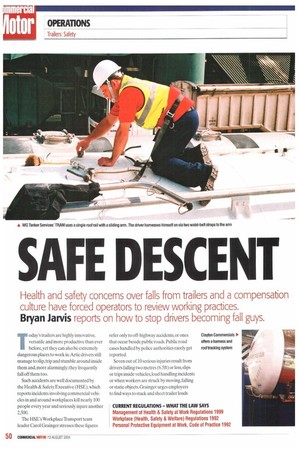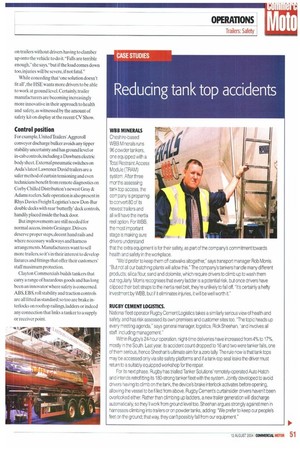SAFE DESCENT
Page 50

Page 51

If you've noticed an error in this article please click here to report it so we can fix it.
Health and safety concerns over falls from trailers and a compensation culture have forced operators to review working practices. Bryan Jarvis reports on how to stop drivers becoming fall guys.
Today's trailers are highly innovative, versatile and more productive than ever before, yet they can also be extremely dangerous places to work in.Artic drivers still manage to slip, trip and stumble around inside them and, more alarmingly; they frequently fall off them too.
Such accidents are well documented by the Health & Safety Executive (HSE),which reports incidents involving commercial vehicles in and around workplaces kill nearly 100 people every year and seriously injure another 2,500.
The HSE's Workplace Transport team leader Carol Grainger stresses these figures refer only to off-highway accidents, or ones that occur beside public roads. Public road cases handled by police authorities rarely get reported.
Seven out of 10 serious injuries result from drivers falling two metres (6.5ft) or less, slips or trips inside vehicles, load handling incidents or when workers are struck by moving, falling or static objects. Grainger urges employers to find ways to stack and sheet trailer loads on trailers without drivers having to clamber up onto the vehicle to do it. "Falls are terrible enough," she says, "but if the load comes down too, injuries will be severe, if not fatal."
While conceding that 'one solution doesn't fit all', the HSE wants more drivers to be able to work at ground level. Certainly, trailer manufacturers are becoming increasingly more innovative in their approach to health and safety, as witnessed by the amount of safety kit on display at the recent CV Show.
For example, United Trailers' Aggreroll conveyor discharge bulker avoids any tipper stability uncertainty and has ground level or in-cab controls, including a Dawbarn electric body sheet. External pneumatic switches on Asda's latest Lawrence David trailers are a safer method of curtain tensioning and even technicians benefit from remote diagnostics on Corby Chilled Distribution's newest Gray & Adams reefers. Safe operation is also present in Rhys Davies Freight Logistics's new Don-Bur double decks with rear 'butterfly' deck controls, handily placed inside the back door.
But improvements are still needed for normal access, insists Grainger. Drivers deserve proper steps, decent hand rails and where necessary walkways and harness arrangements. Manufacturers want to sell more trailers, so it's in their interest to develop fixtures and fittings that offer their customers' staff maximum protection.
Clayton Commercials builds tankers that carry a range of hazardous goods and has long been an innovator where safety is concerned. ABS, EBS, roll stability and traction controls are all fitted as standard:so too are brake interlocks on rooftop railings, ladders or indeed any connection that links a tanker to a supply or receiver point.
























































































































































































